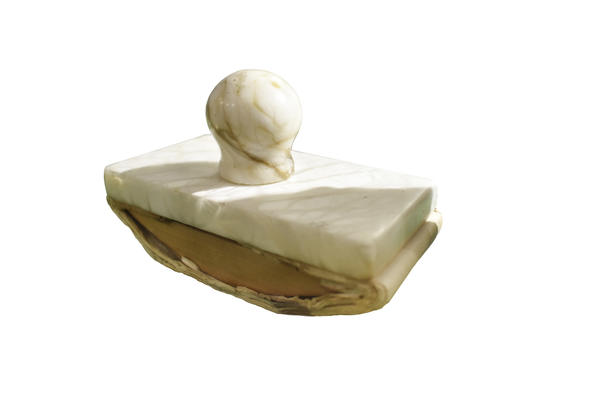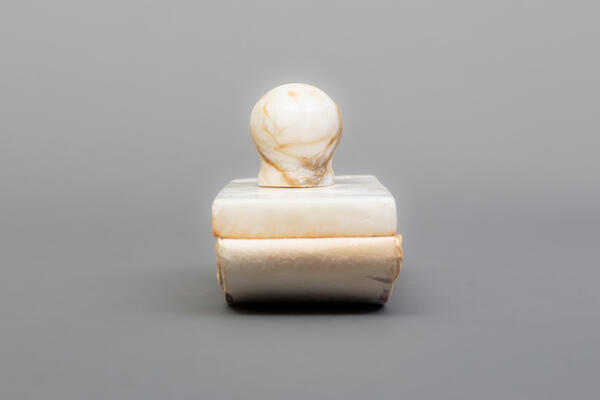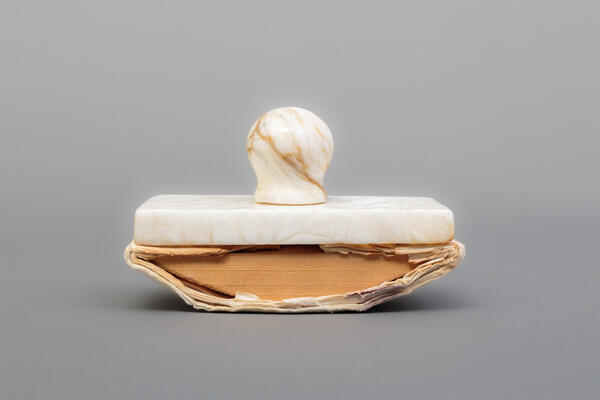A rocker blotter is a piece of a desk accessory set that has evolved from a simple paperweight to a rare collector’s item.
The first paperweights were ordinary stone or metal blocks used to keep things tidy on a desk: they were used to press papers together so that they didn’t get mixed up and fly away in draughts. As this was a practical necessity for respectable people, the blocks were made of ornamental or semi-precious stones at the base and decorated with metal or stone figurines or decorative elements on top.
In the early 19th century, the ink was dried by sprinkling the written text with fine sand from a special table sandbox. In 1835 blotting paper joined the indispensable writing utensils. It was unsized, slightly pressed, made of almost pure pulp. Thanks to its pores, it could effectively absorb moisture and remove smudges without smearing the text. Such paper, along with writing and letter paper, was stored in a special, ornate writing case.
Almost at the same time as blotting paper, a new kind of paperweights — rocker blotters — appeared. Having gained a new function, it changed its shape. The lower part of the item, on which paper was stretched in several layers, became convex, arched or crescent-shaped. Valuable types of wood such as oak, walnut, mahogany and ebony were often used. Bronze or silver edging was added to the sides of the base. The top of the rocker blotter was still crowned by a knob and decorative elements: porcelain, glass, and metal figurines, as well as inlays and precious stones. In this form, the desk item was now considered a work of art and was intended to demonstrate its owner’s status and good taste.
Rocker blotters lost their practical significance in the mid-20th century when production of ballpoint pens was established in the USSR. But even today they often adorn the desks of businessmen and the collections of antique connoisseurs.
The first paperweights were ordinary stone or metal blocks used to keep things tidy on a desk: they were used to press papers together so that they didn’t get mixed up and fly away in draughts. As this was a practical necessity for respectable people, the blocks were made of ornamental or semi-precious stones at the base and decorated with metal or stone figurines or decorative elements on top.
In the early 19th century, the ink was dried by sprinkling the written text with fine sand from a special table sandbox. In 1835 blotting paper joined the indispensable writing utensils. It was unsized, slightly pressed, made of almost pure pulp. Thanks to its pores, it could effectively absorb moisture and remove smudges without smearing the text. Such paper, along with writing and letter paper, was stored in a special, ornate writing case.
Almost at the same time as blotting paper, a new kind of paperweights — rocker blotters — appeared. Having gained a new function, it changed its shape. The lower part of the item, on which paper was stretched in several layers, became convex, arched or crescent-shaped. Valuable types of wood such as oak, walnut, mahogany and ebony were often used. Bronze or silver edging was added to the sides of the base. The top of the rocker blotter was still crowned by a knob and decorative elements: porcelain, glass, and metal figurines, as well as inlays and precious stones. In this form, the desk item was now considered a work of art and was intended to demonstrate its owner’s status and good taste.
Rocker blotters lost their practical significance in the mid-20th century when production of ballpoint pens was established in the USSR. But even today they often adorn the desks of businessmen and the collections of antique connoisseurs.






